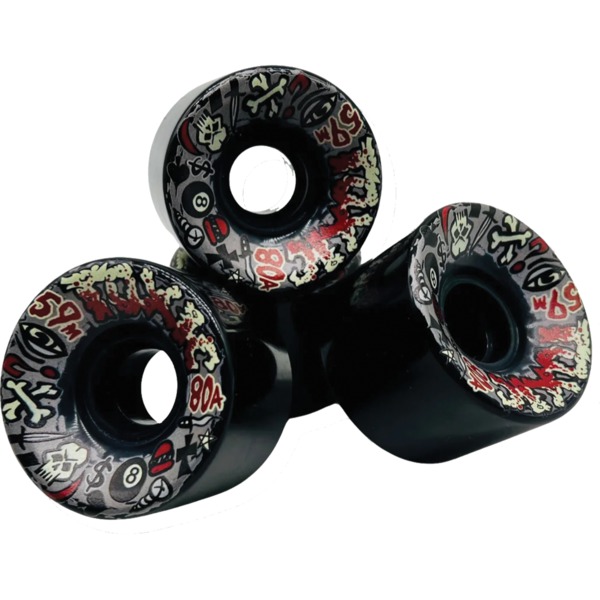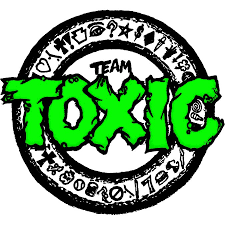
Toxic Skate Wheels
About Toxic Skate Wheels
In 1974, Patrick Truitt met Josh Marlowe on the boardwalk in Ocean City, Maryland and they became instant friends. Josh introduced Patrick to skateboarding and his life-long love of the sport has continued ever since. Spurred by Patrick's enthusiastic interest in the sport, his father dove head first into learning everything possible about skateboards and realized there was a major void in the industry. He went on to start the world's first skateboard distribution company and helped launch the careers of many of yesterday and today's industry leaders, thus solidifying Patrick and the Truitt Family as one of the founding families of the skateboard products industry.
In 1978, their family started deck manufacturing for Kryptonics and in 1981, fully took over making all Kryptonics skateboards, as their High Energy line. Over the next few years, throughout the 1980s, they expanded the distribution business worldwide and purchased Brand-X Skateboards in 1986 from Bernie Tostenson (the former Sims artist who started the company), and in 198& they created Toxic Skates, as a spin-off of the PA demo skate group, Team Toxic.
Throughout the 80s and early 90s, they built Toxic, Brand-X and High Energy into major, global brands, Then (when the skateboard industry changed in the mid 90s), they decided to stop manufacturing and focus solely on the distribution business. Decades later, in 2015, Patrick, along with his partner, Amy brought back Brand-X, Toxic and High Energy under their company, Brand-X Skateboards.
Today, Patrick and Amy continue to proudly make these much-loved global brands, plus American Nomad, Kanoa and many others, using the only the highest quality North American products and workmanship, with personalized customer service, and a true love for the industry and skateboarders worldwide.
Shop by Category
Skateboard Decks Specs
- Deck width: 7.6" and larger
- Ages 13 years old and older
- Skater height 5'3" and taller
- Size 9 shoes or larger
Skateboard Completes Specs
- Deck width: 7.6" and larger
- Ages 13 years old and older
- Skater height 5'3" and taller
- Size 9 shoes or larger
Micro Decks Specs
- Deck width: 6.75" or smaller
- Ages 5 years old or younger
- Skater height 3'4" and under
- Size 3 shoes or smaller
Mini Decks Specs
- Deck width: 7.0"
- Ages 6 to 8 years old
- Skater height between 3'5" & 4'4" tall
- Size 4-6 shoes
Mid Decks Specs
- Deck width: 7.3" - 7.6"
- Ages 9 to 14 years old
- Skater height between 4'5" & 5'2" tall
- Size 7-8 shoes
Micro Completes Specs
- Deck width: 6.75" or smaller
- Ages 5 years old or younger
- Skater height 3'4" and under
- Size 3 shoes or smaller
Mini Completes Specs
- Deck width: 7.0"
- Ages 6 to 8 years old
- Skater height between 3'5" & 4'4" tall
- Size 4-6 shoes
Mid Completes Specs
- Deck width: 7.3" - 7.6"
- Ages 9 to 14 years old
- Skater height between 4'5" & 5'2" tall
- Size 7-8 shoes
Let Us Grip Tape Your Board
Don’t feel comfortable gripping up your new board? No need to worry. Avoid uneven lines and unwanted air bubbles by letting our professionals grip your new deck for you.
Let Us Build Your Skateboard
Do you want Warehouse Skateboards to Assemble your Complete Skateboard?
This service includes:
- Professionally gripping the skateboard deck. Insuring no bubbles and a nice clean cut around the edge.
- Pressing 8 skateboard bearings into 4 wheels. Each bearing will be seated with a professional bearing press and will include bearing spacers when necessary.
- Assembly of skateboard trucks and wheels. Both truck assemblies will have wheels installed with proper speed washers and torqued to the appropriate tolerance.
- Installing both truck assemblies to the gripped deck and assuring proper torque tolerance on all hardware.
- An autographed Warehouse Skateboards hang tag from your builder.
Skateboard Hardware Sets
Skateboard hardware is used to connect the skateboard trucks to the skateboard deck. Skateboard hardware refers to the bolts and locknuts used when building a board. The bolts can have an Allen or Phillips head. Skateboard hardware comes in many different lengths, and often includes one different colored bolt so that the rider can mark the nose of their board.
Each skateboard hardware set includes 8 bolts and 8 locknuts needed to assemble one skateboard.
What size hardware do I need to put together my skateboard?
- 7/8" to 1" hardware - no riser
- 1" to 1 1/8" hardware - 1/8" riser
- 1 1/4" hardware - 1/4" riser
- 1 1/2" hardware - 1/2" riser
The width of your truck axle should closely match the width of your skateboard deck, usually within 1/4”.
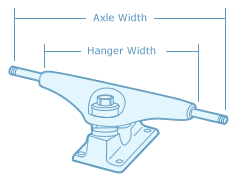
For additional info visit our
Skateboard Trucks Buying Guide
Truck height is measured from the bottom of the truck’s baseplate to the center of the axle. In general, a mid-sized truck works well for most skateboarders, but high or low trucks may be preferred for different styles of skaters.
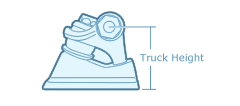
LO - Provides extra stability for flip tricks, designed for small wheels (50-53mm wheel size recommended).
MID - Good all-around profile for street or park (53-56mm wheel size recommended).
HIGH - Great for cruising and carving, designed for large wheels (56mm+ wheel size recommended).
For additional info visit our
Skateboard Trucks Buying Guide
The hanger is the truck's T-shaped aluminum alloy grind area. It makes direct contact with rails and curbs. The hanger holds the axle on which the wheels are mounted. Hangers weigh about 10-13 oz, with lighter ones available. The width of your truck axle should closely match the width of your skateboard deck, usually within 1/4”.

For additional info visit our
Skateboard Trucks Buying Guide
Construction refers to the material(s) used in fabrication or the specific brand technology.
For additional info visit our
Skateboard Buying Guide
The average width of a skateboard deck is 7.5"- 8.25". Width is influenced by the size of the rider and the type of riding. Bigger riders and those skating ramps typically prefer a wider deck. Street skaters usually choose a smaller deck. Choose your skateboard deck according to the width, not length. Here are some general guidelines:
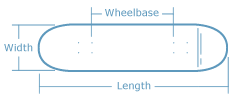
MICRO - Deck width: 6.75" or smaller - 5 years old or younger, under 3'4" tall. Size 3 shoes or smaller.
MINI - Deck width: 7.0" - 6 to 8 years old between 3'5" & 4'4" tall. Size 4-6 shoes.
MID - Deck width: 7.3" - 9 to 12 years old between 4'5" & 5'2" tall. Size 7-8 shoes.
FULL - Deck width: 7.5" or larger - for all skaters over age 13, taller than 5'3" with a shoe size of 9 or up.
7.5" to 8"
Standard board for adult riders skating streets or doing more technical tricks
8.0" to 8.25"
Skating pools, ramps and parks
8.25" and larger
Vert, pools, cruising and just going old school
Still having a hard time with size, try our Skateboard Sizer
For additional info visit our
Skateboard Decks Buying Guide
Deck type refers to the size or style (shape) of the skateboard deck. If you are a beginner, choose your deck according to the width, not the length. The width you need depends on your size, skating style and personal preference. Here are some general guidelines:

MICRO - Deck width: 6.75" or smaller - 5 years old or younger, under 3'4" tall. Size 3 shoes or smaller.
MINI - Deck width: 7.0" - 6 to 8 years old between 3'5" & 4'4" tall. Size 4-6 shoes.
MID - Deck width: 7.3" - 9 to 12 years old between 4'5" & 5'2" tall. Size 7-8 shoes.
FULL - Deck width: 7.5" or larger - for all skaters over age 13, taller than 5'3" with a shoe size of 9 or up.
Cruisers, Old School, Freestyle, Longboard and Downhill all refer to a skateboarding style and the corresponding shape.
For additional info visit our
Skateboard Decks Buying Guide
Length is measured from the tip of the nose to the tip of the tail. Average board length is 28"- 32" and longboards can range 32" and larger, but length is only referred to by advanced skaters.

For additional info visit our
Skateboard Decks Buying Guide
Wheel size or diameter - All Skateboard wheels are measured in millimeters (mm). The smaller the number, the smaller the wheel. Smaller wheels are slower; bigger wheels are faster.
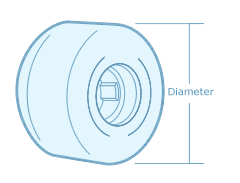
50-53mm - Small slower wheels, stable for trick riding and smaller riders skating street, skate parks and bowls.
54-59mm - Average wheel size for beginners and bigger riders skating street, skate parks, bowls and vert ramps.
60mm + - Specialty riders skating longboards, old-school boards, downhill and dirt boards; made for speed and rougher surfaces.
For additional info visit our
Skateboard Wheels Buying Guide
Durometer measures the wheel’s hardness. Harder wheels are faster; softer wheels are slower but have better grip.
78a-87a - Soft wheel good for rough surfaces, longboards or street boards that need lots of grip and easier to roll over cracks and pebbles. Designed for a smooth ride cruising, longboards, hills and rough surfaces.
88a-95a - Slightly harder and faster with a little less grip, but the grip's still good. Street; rough surfaces.
96a-99a - Good speed and grip - an all-around wheel. Great for beginners skating street, skate parks, ramps and pools. Smooth surfaces.
101a + - Hardest and fastest wheel with the least grip. Ineffective on slick and rough surfaces. These are pro wheels.
83b-84b - Wheels using the B scale are extremely hard, measuring 20 points lower than the the A Scale in order to allow the scale to extend another 20 points for harder wheels.
For additional info visit our
Skateboard Wheels Buying Guide
The laws for skateboarding helmets vary from state to state. Many states require that skaters wear a helmet under a certain age, and some states like California make all skaters under 18 wear a CPSC Certified helmet at all times. CSPC skateboard helmets usually have an EPS protective liner that meets the safety standards for skateboarding. Make sure you check your state's regulations before ordering.
CPSC Certified Helmets: California requires that all skateboard helmets must meet the requirements of the United States Consumer Product Safety Commission (CPSC). Section 890.4 of the Streets and Highways Code enforces these standards in California and will not allow Warehouse Skateboards to ship non-CPSC Certified helmets to California.
For additional info visit our
Skateboard Helmets Guide
Unsure of the size you need?
Visit our Clothing Sizing Charts
Note: Each brands skateboard helmet size will vary; therefore, it is best to measure your head and refer to the sizing chart specific to each brand of helmet. In order to properly measure your head, follow these steps:
Wrap a soft tape measure around your forehead, just above your eyebrows and ears. Keep the tape measure level from the front to the back of your head. Your skateboard helmet should sit low on your forehead.
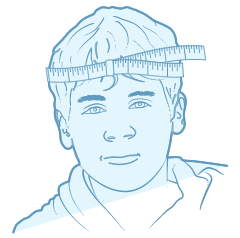
If you do not have a flexible tape measure, try marking a string and measuring it against a ruler.
If the helmet is a gift or you cannot measure the skater's head, measure the inside of a current helmet or hat they wear.
Within each skateboard helmet product page there are specific measurements for each skate brand. Use that information, along with your head size, to determine your correct helmet size before placing your order. This will ensure that you receive the best fit.
For additional info visit our
Sizing Skateboard Helmets
